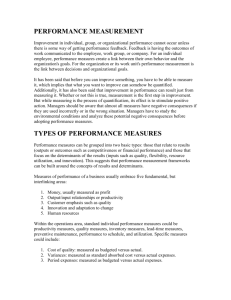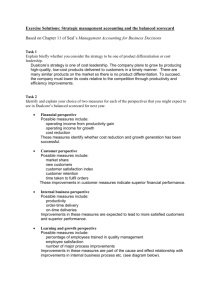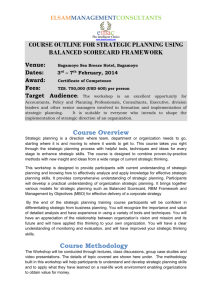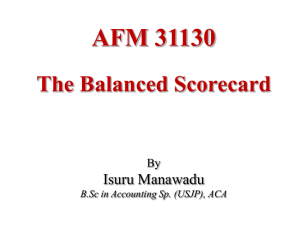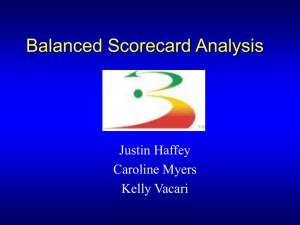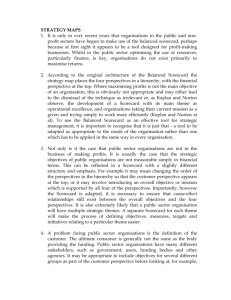Implementing performance measurement systems: a literature
advertisement
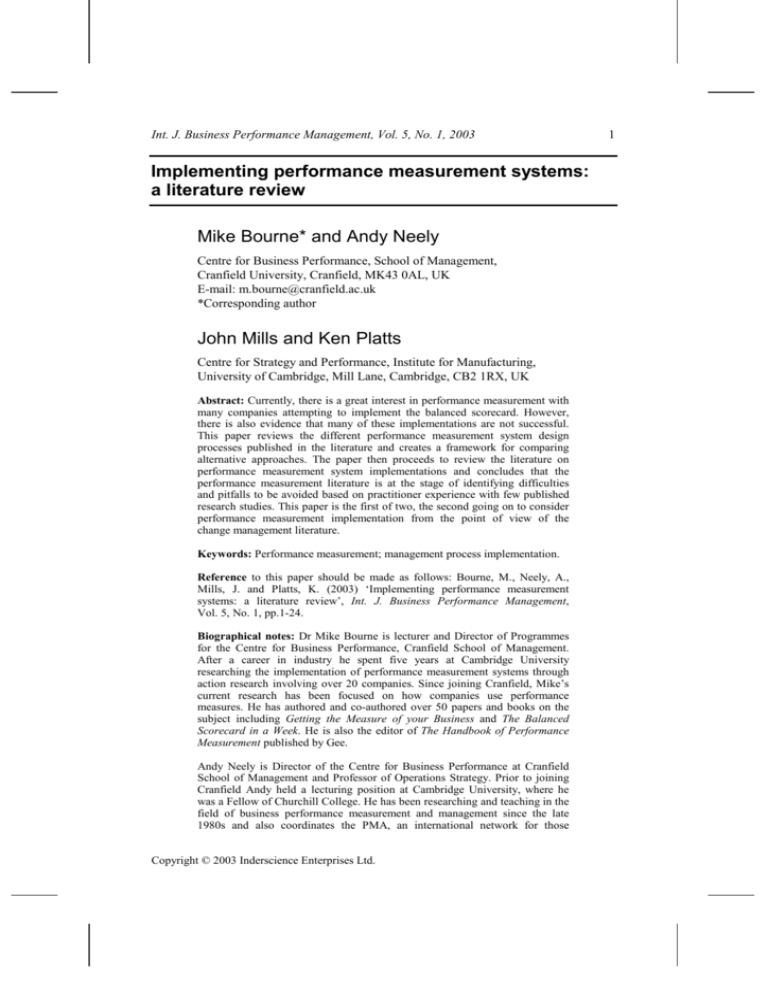
Int. J. Business Performance Management, Vol. 5, No. 1, 2003 Implementing performance measurement systems: a literature review Mike Bourne* and Andy Neely Centre for Business Performance, School of Management, Cranfield University, Cranfield, MK43 0AL, UK E-mail: m.bourne@cranfield.ac.uk *Corresponding author John Mills and Ken Platts Centre for Strategy and Performance, Institute for Manufacturing, University of Cambridge, Mill Lane, Cambridge, CB2 1RX, UK Abstract: Currently, there is a great interest in performance measurement with many companies attempting to implement the balanced scorecard. However, there is also evidence that many of these implementations are not successful. This paper reviews the different performance measurement system design processes published in the literature and creates a framework for comparing alternative approaches. The paper then proceeds to review the literature on performance measurement system implementations and concludes that the performance measurement literature is at the stage of identifying difficulties and pitfalls to be avoided based on practitioner experience with few published research studies. This paper is the first of two, the second going on to consider performance measurement implementation from the point of view of the change management literature. Keywords: Performance measurement; management process implementation. Reference to this paper should be made as follows: Bourne, M., Neely, A., Mills, J. and Platts, K. (2003) ‘Implementing performance measurement systems: a literature review’, Int. J. Business Performance Management, Vol. 5, No. 1, pp.1-24. Biographical notes: Dr Mike Bourne is lecturer and Director of Programmes for the Centre for Business Performance, Cranfield School of Management. After a career in industry he spent five years at Cambridge University researching the implementation of performance measurement systems through action research involving over 20 companies. Since joining Cranfield, Mike’s current research has been focused on how companies use performance measures. He has authored and co-authored over 50 papers and books on the subject including Getting the Measure of your Business and The Balanced Scorecard in a Week. He is also the editor of The Handbook of Performance Measurement published by Gee. Andy Neely is Director of the Centre for Business Performance at Cranfield School of Management and Professor of Operations Strategy. Prior to joining Cranfield Andy held a lecturing position at Cambridge University, where he was a Fellow of Churchill College. He has been researching and teaching in the field of business performance measurement and management since the late 1980s and also coordinates the PMA, an international network for those Copyright © 2003 Inderscience Enterprises Ltd. 1 2 M. Bourne, A. Neely, J. Mills and K. Platts interested in the subject. Andy has authored over 100 books and articles, including Measuring Business Performance, published by the Economist and The Performance Prism, published by the Financial Times. John Mills spent 20 years with Shell International and Philips Electronics prior to joining the University of Cambridge in 1992. His industrial experience is in oil exploration and production support and factory, development and business management in consumer electronics, white goods and mobile communications sectors. His research has focused on the development of practical processes for the formation and implementation of manufacturing strategies and the design of coherent performance measurement systems. He was the lead author on the workbook Creating a Winning Business Formula, co-author of Getting the Measure of Your Business and lead author on Competing through Competences, published by Cambridge University Press in July 2002. Dr. Ken Platts is a University Reader in Manufacturing and heads the Centre for Strategy and Performance at the University of Cambridge, UK. He is a chartered engineer and has had a varied career in both industry and academia. His current research interests include manufacturing strategy, performance measurement, and make or buy issues. He has recently co-authored a Strategy and Performance trilogy, published by Cambridge University Press, 2002, which, aimed primarily at industrial managers, describes practical approaches to developing strategy and measuring performance. 1 Introduction Judging by attendance at business conferences and writing on the subject [1], performance measurement has become a popular topic for both industrialists and academics, reaching the stage of being identifiable as a specific subset in the operations management literature [2]. Recent research by Hackett Group suggests that the balanced scorecard [3] is becoming a widely used performance measurement tool in the USA. However, despite this popularity, there is evidence that not all performance measurement initiatives are successful [4–7]. Other researchers have claimed that 70% of attempts to implement performance measurement systems fail [8]. Therefore, the objective of this paper is to contribute to a better understanding of the factors which influence the success or failure of performance measurement initiatives through reviewing the literature. The paper starts by considering the definitions used in performance measurement and, as the field is still rapidly evolving, the current meaning of the terms. The paper then goes on to briefly trace the background to the development of performance measurement and the main performance measurement frameworks. The main management processes for designing and implementing performance measurement systems are identified, described and categorised to provide an understanding of the methods currently in use. Finally, the paper reviews the literature on implementation which is predominantly based on the reflections of practitioners. This paper is the first of two, the second going on to consider performance measurement implementation from the point of view of the change management literature. Implementing performance measurement systems: a literature review 2 3 Performance measurement definitions In answering the question, ‘what is performance measurement?’ it is useful to start with definitions which have been used in the literature. To quote Neely et al. [9] “Performance Measurement is a topic often discussed but rarely defined”. Following their comment concerning definitions, Neely et al. [9] went on to propose definitions of performance measurement, a performance measure and a performance measurement system. These were: “Performance measurement can be defined as the process of quantifying the efficiency and effectiveness of action.” “A performance measure can be defined as a metric used to quantify the efficiency and/or effectiveness of action.” “A performance measurement system can be defined as the set of metrics used to quantify both the efficiency and effectiveness of actions.” These definitions are precise, but their very precision means that they do not convey what is now being labelled in the literature and in practice as ‘performance measurement’ [10]. For example, the literature review in this paper will show: • Performance measurement (as promoted in the literature and practised in leading companies) refers to the use of a multi-dimensional set of performance measures. The set of measures is multi-dimensional as it includes both financial and non-financial measures, it includes both internal and external measures of performance and it often includes both measures which quantify what has been achieved as well as measures which are used to help predict the future. • Performance measurement cannot be done in isolation. Performance measurement is only relevant within a reference framework against which the efficiency and effectiveness of action can be judged. In the past, performance measurement has been criticised for judging performance against the wrong frame of reference and now there is widespread support for the belief that performance measures should be developed from strategy. • Performance measurement has an impact on the environment in which it operates. Starting to measure, deciding what to measure, how to measure and what the targets will be, are all acts which influence individuals and groups within the organisation. Once measurement has started, the performance review will have consequences, as will the actions agreed upon as a result of that review. Performance measurement, is therefore, an integral part of the management planning and control system of the organisation being measured. • Performance measurement is now being used to assess the impact of actions on the stakeholders of the organisation whose performance is being measured. Although this can be considered ‘as quantifying the efficiency and effectiveness of action’, in the case of measuring the impact of the organisation’s performance on customer satisfaction, it is not as obvious in the cases of measuring the impact of the organisation’s actions and performance on employee satisfaction or local community satisfaction. 4 M. Bourne, A. Neely, J. Mills and K. Platts Therefore, although the Neely et al. [9] definitions are still valid, the concept of performance measurement used in this paper refers to the use of a multi-dimensional set of performance measures for the planning and management of a business. Having identified what is meant by performance measurement, the next section reviews the literature to explain in more detail how the concept of performance measurement has developed. 3 The evolution of performance measurement Performance measurement has its roots in early accounting systems and Johnson [11, p.512] cites the Medici accounts as an excellent example of how a pre-industrial organisation could maintain a good account of external transactions and stock without recourse to higher-level techniques, such as cost accounting. However, as industrial organisations developed, so did their needs for measures and Johnson [12] provides a detailed account of how current management accounting developed in the USA between the 1850s and 1920s as industrial organisations moved from piece-work to wages [11]; single to multiple operations [11,13]; individual production plants to vertical integrated businesses [13] and individual businesses to multi-divisional firms [14]. As a result, following the First World War, companies such as du Pont, Sears Roebuck and General Motors were starting to use sophisticated budgeting and management accounting techniques [15], such as standard costing, variance analysis, flexible budgets, return on investment and other key management ratios. From these beginnings, the use of budgets spread. A study showed that by 1941, 50% of well established US companies were using budgetary control in one form or another [16] and by 1958, budgets appeared to be used for overall control of company performance by 404 out of 424 (just over 95%) participating in the study [17]. However, between 1925 and the 1980s, there were no significant developments in management accounting [18] and by the 1980s, traditional accounting measures were being criticised as inappropriate for managing businesses of the day. Criticism focused on the dysfunctional behaviour traditional accounting based performance measures encouraged [19] especially when used inappropriately [20,21]. In particular, they were criticised for encouraging short-term decision making [22–25], their inapplicability to modern manufacturing techniques [26–28], and the damage they were causing to business and, therefore, the US economy [29]. Traditional accounting based performance measures have been characterised as being financially based, internally focused, backward looking and more concerned with local departmental performance than with the overall health or performance of the business [18,30,9,31]. As a consequence, in the late 1980s and early 1990s there was a great interest in the development of more balanced performance measurement systems with the creation of frameworks such as Keegan et al.’s [30] supportive performance measures matrix, the SMART pyramid [32], the Results/Determinants Matrix [33,34] and the Balanced Scorecard [3]. These frameworks overcame many of the shortcomings of traditional financially based accounting systems but, despite criticisms [35], with the recent growth of the concept of measuring the satisfaction of all the stakeholders [36–39] new frameworks are still emerging such as the Performance Prism [40]. Implementing performance measurement systems: a literature review 5 However, as Otley [41] points out, frameworks on their own are not a complete solution. Frameworks do provide different perspectives for categorising performance measures, allowing one to consider the balance between the demands on the business. But, they do not tell a company what to measure [42] and there is no mechanism for specifying the objectives which should be met [43]. Performance measurement needs to be integrated into the management of the business [44] and there are now management processes developed to do just this. These processes are reviewed in the next section. 4 Performance measurement design processes In the performance measurement literature, a wide range of performance measurement design processes is described. These processes have been developed both jointly and severally, from theory and practice, by both academics and practitioners. Some have remained as theoretical models whereas others have been extensively tried and tested through application in commerce and industry. In order to make sense of the literature on the processes for performance measurement design, the following approach is adopted. Firstly, a categorisation is developed which separates the main forms of management process for the design of performance measurement systems. Secondly, the most important examples of each category are described. Thirdly, other processes from the literature are summarised under these categories. 4.1 Categorising performance measurement design processes In the literature, there have been very few attempts to compare and contrast the different performance measurement design processes. Bititci et al. [45] attempted to compare the characteristics of different frameworks, processes and systems using practitioner requirements as the criteria, but this approach did not fully distinguish between frameworks, systems and processes, nor did it attempt to create a categorisation. Categorising the performance measurement design processes described in the literature is not an easy task. Some are no more than a brief description of a series of tasks (e.g. [46]); others are descriptions of single tools (e.g. [47]) whilst a few are complete processes (e.g. [48,49]). In addition, some are consultancy techniques that are only partially published (e.g. [50,51]). However, the literature does provide sufficient information to attempt a categorisation. The first theme that is immediately apparent from the literature is that the procedures are not the same. In fact, the underlying bases for developing the performance measurement systems are very different. For example, Kaplan [52] describes the process of assessing customer needs as the basis of his approach, Dixon et al. [53] have as a basis their audit technique and Bitton [54] the ECOGRAI model. These differences in procedures are therefore one source of categorisation. However, as Platts [55,56] demonstrated, procedure is not the only important criteria. From a change management or implementation perspective, how it is done [57], the process consultation [58], facilitation [59] and the structuring of the debate [60] are all important aspects that cannot be ignored. These softer aspects of the process are less explicitly addressed in the literature and have to be gleaned from careful reading. Given 6 M. Bourne, A. Neely, J. Mills and K. Platts that developing a new performance measurement system is a learning process [61] and that participation and engagement is critical for a successful outcome [62], this creates a second source of categorisation. In summary, the literature suggests that two distinct dimensions can be used: • the underlying procedure, which could be considered the ‘hard’ issues • the underlying approach, in terms of the role of the process leader, change agent or consultant, which could be considered the ‘soft’ issues. These are now discussed. 4.2 The procedures From the literature, three distinctive procedures can be discerned. These are described here and labelled as ‘needs led’, ‘audit led’ and ‘model led’. 4.2.1 The ‘needs led’ procedure The needs led approach is a top down procedure for developing performance measures, where the customer, business and stakeholder needs are severally or jointly identified and used as a basis for the development of performance measures. In this approach, the measures are designed to monitor the business’s progress towards achievement of these needs. Examples of this approach include the different processes for designing the balanced scorecard [50,52,63] and ‘Getting the measure of your business’ [49,64]. 4.2.2 The ‘audit led’ procedure The audit led procedure can be considered more of a bottom up approach to the design of a performance measurement system, starting with an audit of the existing performance measures. The information collected is then used to challenge the status quo and as a basis for amending the existing performance measures. Examples of this approach include the Performance Measurement Questionnaire [53]. 4.2.3 The ‘model led’ procedure The model led approach uses a prescribed theoretical model of the organisation as a rationale for designing the performance measures that should be deployed. Examples of this approach include ECOGRAI [54] and Fraunhofer [65]. 4.3 The approach In considering the ‘soft’ issues, all the published process as are what might be considered partial processes [66] in that they focus primarily on Lewin’s [67] phase of unfreezing, with little consideration to moving and refreezing. Given this, there are still two distinct types of approach that can be identified in the literature. These have been labelled here ‘consultant led’ and ‘facilitator led’. Implementing performance measurement systems: a literature review 7 4.3.1 The ‘consultant led’ approach The ‘consultant led’ approach is where the majority of work is undertaken by an individual (or group of individuals, usually consultants – hence the term used here) almost in isolation from the rest of the management team. The approach is typified by a small number of workshops, well spaced apart in time, where the work of the consultant is reviewed. Between the workshops, the consultant undertakes his or her work. Data collection is undertaken, usually through interviews with individual mangers. The consultant then does the analysis and the results are presented back to the management team at the next workshop in the form of a report with recommended actions. Although it is at the senior management workshops that the main decisions are made, the majority of the work is done outside these meetings. An example of this is the ‘Putting the balanced scorecard to work’ approach [63] described later. 4.3.2 The ‘facilitator led’ approach The ‘facilitator led’ approach is different in that the majority of the work is undertaken by the management team together in facilitated workshops. Consequently, the management team’s role is not restricted to critiquing work done by others. In these workshops they are intimately involved in the discovery and analysis phases of the work. The role of the facilitator now revolves around eliciting information from the assembled group, structuring the debate, probing the assumptions and, if necessary, challenging the decisions made. An example of this is the later approach to developing balanced scorecards ‘Translating strategy into action’ [68,69] and ‘Getting the measure of your business’ [49]. Figure 1 summarises this framework and categorises the processes identified. Figure 1 Categorisation of performance measurement design processes Needs Led Consultant Led Facilitator Led Putting the balanced scorecard to work, Translating strategy into action Kaplan and Norton [63] Kaplan and Norton [50] and Managing with Measures, Norton [69] Andersen Consulting [70] Getting the measure of your business, Total Cycle Time, Neely et al. [48] Thomas and Martin [71] Performance Drivers, Olve et al. [30] Audit Led PMQ, Not Available Dixon et al. [72] IPDMS, Ghalayini et al. [73] Reference Model, Bititci et al. [47] Model Led ECOGRAI, Fraunhofer Bitton [53] Krause and Mertins [65] 8 5 M. Bourne, A. Neely, J. Mills and K. Platts The main performance measurement design processes In this section the main performance measurement design processes are briefly described and reviewed in turn. 5.1 Putting the balanced scorecard to work Since Kaplan and Norton’s [3] initial article in Harvard Business Review, the application of the balanced scorecard has been developed and refined through consulting practice. The initial process describes in outline the seven stages for developing and implementing a balanced scorecard [63]. The process uses both consultant interviews and executive workshops in the development of a shared set of business objectives and measures. This process has been developed by the introduction of tools to capture the customer perspective. Kaplan [52] described how an external customer view was introduced into the scorecard development process in the Rockwater case. Here, customer interviews were recorded and analysed. This technique developed a new customer perspective for Rockwater and allowed the company to segment its market and to develop strategies, actions and measures that underpinned the development of its chosen niche. In summary, this is a ‘needs led and consultant led’ process as, in the main, consultants are used to either elicit the business needs through interviewing executives or to capture the customer needs through interviews. 5.2 The performance model The original idea of the performance model was based on the concept that senior managers have in their minds a set of beliefs about how the business operates and how performances in different parts of the business interact with each other. Eccles and Pyburn’s [47] contribution was to suggest that these models should be shared and jointly developed between the members of the senior management team, making this explicit by creating a performance model. The concept has been developed by Kaplan and Norton [50] and the Metro Bank example [68] illustrates the type of outcome generated by this approach (see Figure 2). The process [74] for creating such a business model involves facilitating the senior management team through a review of their business strategy by asking two questions: • ‘What is the objective to be achieved?’ • ‘How do we achieve this?’ By asking these questions repeatedly at each level, objectives can be broken down to create a performance model. An example of two stages is shown in Figure 3. Implementing performance measurement systems: a literature review Figure 2 9 The Metro Bank Strategy The revenue growth strategy Financial Perspective The productivity strategy Improve returns Broaden revenue mix Improve operating efficiency Increase customer confidence in our financial advice Increase customer satisfaction through superior execution Customer Perspective Internal Perspective Understand customer segments Develop new products Cross-sell the product line Innovation & Learning Perspective Shift to appropriate channel Minimise problems Increase Employee Productivity Develop strategic skills Source: Kaplan and Norton [68] Access to strategic information Align personal goals Provide rapid response 10 M. Bourne, A. Neely, J. Mills and K. Platts Figure 3 The ‘what how’ technique Stage 1 Increase return on assets Increase sales "What" Reduce Costs "How" Stage 2 Increase return on assets Increase sales Reduce Costs "What" "How" "What" "How" Stage 3, .... Norton [69] claims that business executives have within their understanding very sophisticated models of business performance. These can be exploited and used to develop the initial balanced scorecard. But once these have been translated into explicit measures, these models can be tested and refined by the process of performance measurement. Two ways of doing this are by correlation of various measures of performance (e.g. [74–77]) and by simulation of the business through the business performance measures [51]. This latter technique, Norton [69] claims can reveal the ratios of inputs to outputs and help develop the understanding of the time lag between actions and results. In summary, this technique is ‘needs led’ as it breaks down the business needs into specific objectives using a ‘facilitator led’ process to achieve this. 5.3 Getting the measure of your business This is the title of a workbook [49] which details the performance measurement system design process developed and tested by Cambridge University between 1992 and 1995. Implementing performance measurement systems: a literature review 11 The process combines existing concepts such as the balanced scorecard [3], ‘Order Winners and Order Qualifiers’ [78] and Ford’s QOS with other techniques developed at Cambridge. The process is built on the work of Keegan et al. [30], Wisner and Fawcett [79] and Azzone et al. [80], among others. A fuller description of the process testing and development is provided in Neely et al. [42]. Figure 4 shows an outline of the process. In the workbook [49] parts 1 to 5 of the process contain the tools and procedures for developing the top level set of business objectives and designing performance measures for a business unit. For completeness, parts 6 to 10 should be mentioned. These cascade the business objectives by deploying performance measures throughout the organisation. In summary, the first five parts of the process comprise: Part 1 Grouping products • Part 2 Agreeing business objectives • Part 3 by designing individual performance measures for each of the business objectives agreed in part 2 Signing off the top-level performance measures • Part 5 by developing business objectives from customer and stakeholder needs to create a coherent set of top-level business objectives Agreeing performance measures • Part 4 by identifying groups of products (or markets) which have distinct competitive requirements. This is done as different products or markets may have differing customer needs by reviewing the measures developed in part 3, testing them for comprehensiveness and coherence before obtaining agreement for implementation Embedding the top level performance measures • by providing advice on implementation and performance reviews. It is a ‘facilitator led’ process, as the facilitator takes the senior management team through a series of workshop exercises in which they analyse their business. The facilitator’s role is to conduct the workshops, steering and guiding the management team through the process, but the business knowledge and expertise come from the individuals running the business and not the facilitator. 12 M. Bourne, A. Neely, J. Mills and K. Platts Figure 4 A representation of the first five parts of the Neely et al. [49] process The key features of this process are that: • it is a ‘facilitator led’ top down approach • it explicitly takes into account the views of customers and other stakeholders (this adds a dimension not seen in previously published processes) • the process is described at a level of detail which makes it usable by trained facilitators. This detail has been developed through testing and refinement within manufacturing companies [6,42] • the process describes the development of the actual performance measures with guidelines for their design and definition. With the exception of ECOGRAI [54] and more recently Krause and Mertins [65], this aspect is mainly ignored within other processes. Implementing performance measurement systems: a literature review 13 5.4 The performance measurement questionnaire This approach uses a performance measurement questionnaire (PMQ) for evaluating and developing the measures already in use in an organisation [53]. This is based on the premise that measures should appraise, reinforce and reward improvements in performance. Managers need an effective process for designing measures which they can use to meet their unique and evolving needs. Schmenner and Vollmann [81] have pointed out the problems of pursuing the wrong measures. The PMQ is structured in two main parts [72]. Part 1 asks respondents to score the importance of specific improvement areas for the business and to score how effectively the current performance measures gauge improvement. Part 2 asks respondents to score specific performance measures on the extent to which they believe that achieving excellence on the measure is important for the long term health of the company and the extent to which they believe that the company places emphasis on that measure. The PMQ is used as a step in the process. The first stage of the process involves the development of the improvement areas and measures to be addressed by the questionnaire. Once this has been done the questionnaire can be administered to a wide range of managers, supervisors and employees. The PMQ results are then analysed to identify alignment, congruence, consensus and confusion. • Alignment analysis ranks the importance of the improvement areas and the emphasis on measurement. These rankings can be used to assess fit with strategy and fit between the importance of improvement and the emphasis placed on measurement. • Congruence analysis shows the differences between what is considered important to improve and whether the measures support this improvement. They also show which performance measures are important to the company and whether the company emphasises these measures. The term ‘gap’ is used where the business is failing to measure what matters and ‘false alarms’ where the business is reacting to measures which do not matter [53]. • Consensus analysis partitions the data between management levels and functions. The comparison of results can lead to the identification of communication problems when the scores do not agree. • Confusion analysis assesses the variation in responses within groups. The results of the data analysis are shared with the respondents in a workshop. They are used as a catalyst for changing the performance measurement system to improve its alignment, plug the gaps, remove the false alarms, increase consensus by communication and reduce confusion where this exists. However, the format and content of these workshops are not described. The key points of this process are that the PMQ process: 14 M. Bourne, A. Neely, J. Mills and K. Platts • assesses the performance of the existing performance measurement system • allows the development of the existing performance measurement; Eccles [82] has argued that grafting new measures onto an existing system is not the answer, but this is a viable alternative approach for constructing a radical review of the performance measurement system • is relatively light on management time during the audit phase • can be categorised as a ‘consultant led’ approach as management is not greatly involved in the audit process. The workshop development of the new performance measurement system may be more ‘facilitator led’, but the detail is not sufficient to establish this. 6 ECOGRAI The ECOGRAI approach uses a structured methodology which considers the physical, information and decision making systems in the development of performance measures [54]. There are six stages in this approach. The process begins with the detailed analysis of the manufacturing system, capturing the control mechanisms and information flow structure using a technique known as GRAI grids. The GRAI grids split out the main manufacturing functions (e.g., quality, production, maintenance) and analyse these by the three main activities: • management of the activity • planning of the activity • management of the resources used in the activity These functions and activities are then reviewed at three levels, strategic, tactical and operational. From this analysis the main decision centres (MDCs) can be identified. An MDC is an intersection of activity and level which “... has as a consequence of its activities, a main influence in order to achieve the global objectives of the manufacturing system.” [54] For each MDC, the information and decision-making flows are individually identified and mapped. Having modelled the system and identified the MDCs, the next phase in the process cascades the manufacturing system objectives down to the MDCs. A picture is used to display how the top level manufacturing system objectives are linked to the MDC objectives and to verify the coherence. The decision variables are then identified. Decision variables are factors which the decision maker can vary in pursuit of the manufacturing system objectives. The cross-functional consistency of these decision variables is analysed and priorities assigned to manage any conflict identified. The performance indicators are designed from the objective and decision variables. A performance indicator specification sheet is used to document the performance indicator before embedding it within the executive information system. Implementation is Implementing performance measurement systems: a literature review 15 coordinated by three groups and the systems analyst who undertakes the detailed analysis and design work. The three groups are: a synthesis group which oversees and validates the study, functional groups which define the performance measures, and an analysis group which analyses and presents the results from the performance measurement system. The key points of this approach are: • it relies heavily on the underlying model • as originally presented, the process is designed for application within the manufacturing function of a business • it deploys the manufacturing objectives down the organisation • it develops a methodology for the design of measures • a systems analyst is required to conduct most of the detailed analysis • the management’s role is primarily one of coordinating and validating the work as well as coordination between the three groups. 6.1 The Fraunhofer approach The Fraunhofer Institute for Production Systems and Design Technology in Berlin have developed an approach for design performance measurement systems based around the Integrated Enterprise Modelling Method [83] and a process-mapping tool. Based on this method, a common understanding of the value chain can be generated. The process maps are used as the basis for the identification of critical success factors which then define performance indicators required for their perspectives of: • financial results • market structure, in terms of customers, products, competitors • business processes, in terms of volume, value, quality, time and cost • innovation and learning. According to Krause and Mertins [65], these are developed during a facilitated six-stage process, these stages being: 1 develop a value chain process model 2 identify the critical success factors 3 define the performance indicators 4 gather and verify the data 5 evaluate the performance indicators 6 implement a continuous process. The key points of this approach are: • it relies on the underlying model • it is facilitated, with learning occurring during the development of the process maps • it recognises the need for a framework for designing performance measures based round the performance measurement record sheet [84]. 16 M. Bourne, A. Neely, J. Mills and K. Platts 6.2 Summary of the processes In the last section, the main performance measurement design processes have been described. However, to be useable, a management process requires greater detail than the brief descriptions given. Table 1 summarises these approaches and indicates the level of detail published, giving an indication of how useful the different processes are to those who do not have full access to the unpublished information which exists on each within organisations such as consultancies. 7 Performance measurement implementation So far, this paper has focused on reviewing published frameworks and processes that facilitate the design and implementation of performance measurement systems, but little has been written about the implementation of the performance measures themselves. Successful implementations are held up at business conferences as examples of what can be achieved, especially by larger companies such as Mobil [85], DHL [86], TNT, Shell, General Motors and ABB [87]. However, the literature and direct experience of developing and implementing performance measurement systems suggests that successful implementation is not easy. For example, Bungay and Goold [88] describe General Electric Inc.’s experience in the States and quote Jack Welch talking about the three to five years of change which led to their strategic performance measurement system. Jeanes [89] describes the journey that Milliken’s European operations began in the mid 1980s and continued over a 15-year period. Browne [90] stated the process adopted by ABB had a three-year timescale. Even Kaplan and Norton [68] allude to the fact that it takes several years to derive full benefit. More recently, Bourne et al. [91] described in some detail the five year development of performance measurement systems in manufacturing companies and the Mobile case [92] covers a similar period. These more practical approaches suggested that, for many companies, implementing a performance measurement system is not the overnight success presented at the business conferences. Indeed, in one of the few comparative studies available [6], only three out of the six case companies that were observed undertaking a performance measurement design process, went on to implement the majority of the measures agreed during the process. Others have highlighted difficulties with implementation [4,8] and from the authors’ informal discussions with consultants, these rates of success are not untypical of their own experience with implementing performance measurement systems. However, there is little discussion in the literature of the implementation failures. There are a few authors who are writing about the longer-term problems with the use of performance measures [93–95] but that is beyond the focus of this paper. A few authors are writing specifically about the implementation process and those that are state that their findings come primarily from consulting experience. Implementing performance measurement systems: a literature review Table 1 Summary of process approaches to designing performance measurement systems 17 18 M. Bourne, A. Neely, J. Mills and K. Platts Eccles [82] argues that, from his experience of working with organisations implementing performance measurement systems, there are three important factors for the successful updating of a performance measurement system: • developing an information architecture with supporting technology • aligning incentives with the new measurement system • the lead given by the CEO. Interestingly, the Business Intelligence Report [97], which studied latest practice in organisations, also argued that those companies: “.... which already have a sophisticated IT infrastructure and a well developed corporate information architecture are likely to find their ability to develop and support PM systems is greatly enhanced.” The writings from different consulting approaches to the implementation of performance measurement systems have identified other factors, but reached very similar conclusions. Firstly, Kaplan and Norton [68] identified 4 barriers to implementation of performance measurement systems. These were identified through individual cases but quantifiable supporting evidence was provided from a survey of managers attending the Business Intelligence conference in London. These barriers are: 1 Vision and strategy not actionable This occurs when the senior management team have failed to achieve consensus as to how the vision should be achieved. This leads to different groups pursuing different agendas and effort is neither coherent nor linked to strategy in an integrated way. 2 Strategy is not linked to department, team and individual goals When this happens, then those concerned continue to follow the old traditional performance criteria and thwart the introduction of the new strategy. This can be exacerbated by an unaligned incentive system. 3 Strategy is not linked to resource allocation This often occurs when the long term strategic planning process and annual budgeting process are separated and may result in funding and capital allocations becoming unrelated to strategic priorities. 4 Feedback is tactical and not strategic This occurs when feedback concentrates solely on short-term results (such as the financial measures) and little time is reserved for the review of indicators of strategy implementation and success. Kaplan and Norton’s [68] approach is to use aspects of the balanced scorecard design process to overcome these barriers. Secondly, Meekings [98], of Gemini consultants, describes how resistance to the introduction of a performance measurement system may come from lack of Implementing performance measurement systems: a literature review 19 understanding and fear of personal risk. He goes on to describe how three elements of the implementation can overcome this: • a top to bottom measurement architecture • a systematic review architecture • an integrated budgeting and planning process Meekings describes how important the performance measurement design process is for developing a collective understanding of purpose. Adding this point to the three previous elements means that the Gemini approach becomes strikingly similar to that adopted by Kaplan and Norton. Thirdly, Hacker and Brotherton [99] cite the classic problems found in the management of change literature – lack of leadership and resistance to change. Their solution is prescriptive, focusing on pushing the change through, requiring employees to use the system and not being derailed by computer systems and data integrity problems. They also suggest standardising the reporting to save time and effort. Fourthly, Lewy and Du Mee [4] developed their ten commandments, based on the five things a company should do and five things a company should avoid in developing a performance measurement system. Their work provides a useful checklist, but besides their specific recommendations captured with other practioners reflections below, the other suggestions can be accomplished through using a well structured performance measurement system design process. Finally, there have been a number of articles by other practioners reflecting on their experience in designing and implementing performance measurement systems and the difficulties are summarised as follows: • difficulties in evaluating the relative importance of measures and the problems of identifying true ‘drivers’ [5,100] • metrics are too poorly defined [5] • goals are negotiated rather than based on stakeholder requirements [5] • state of the art improvement method is not used [5] • time and expense [4,5,8,101] • the need to quantify results in areas that are more qualitative in nature [100] • large number of measures diluting the overall impact [100] • difficulty in decomposing goals for lower levels of the organisation [5,100] • the need for a highly developed information system [100] • striving for perfection [4,5,8] 8 Conclusion In conclusion, the performance measurement literature is at the stage of identifying difficulties and pitfalls to be avoided based on experience with few published research 20 M. Bourne, A. Neely, J. Mills and K. Platts studies on the topic of implementation successes and failures. However, it must be remembered that there are wide differences between the published approaches to designing and implementing performance measurement systems. In an attempt to create a better understanding of the alternative approaches, this paper has created a framework and categorised published approaches to highlight the differences in practice. In all these approaches, little reference is made to the softer aspects of change that will be encountered during the implementation of a new performance measurement system. It is, therefore, highly likely that a review of the design and implementation processes, from the perspective of the literature on change management, will create further insights into why performance implementations succeed and fail. This is the subject of our second paper [66]. The dearth of research into the success and failure of the implementation of performance measures is an important deficiency in our knowledge of performance measurement. The literature presented above suggests that there are problems and difficulties in implementation of performance measurement systems, which are just beginning to be recognised. To date, our knowledge is based primarily on the reflections of practitioners and, therefore, further comparative studies of the success and failure of the implementation of performance measures in different businesses, using a consistently high quality application of a single process, would add to our knowledge in this area. References 1 2 3 4 5 6 7 8 9 Neely, A.D. (1999) ‘The performance measurement revolution: why now and where next?’, International Journal of Operations and Production Management, Vol. 19, No. 2, pp.205–228. Pilkington, A. and Liston-Heyes, K. (1998) ‘Defining production and operations management: a citation/co-citation study’, in P. Coughlan, A. Dromgoole and J. Peppard (Eds.) Operations Management: Future Issues and Competitive Responses, Papers from the 5th International Conference of the European Operations Management Association, Dublin, Ireland, 14-17 June, published by the School of Business Studies, University of Dublin, Eire, pp.366–371. Kaplan, R.S. and Norton, D.P. (1992) ‘The balanced scorecard–measures that drive performance ‘, Harvard Business Review, Jan./Feb., pp.71–79. Lewy and Du Mee (1998) ‘The ten commandments of balanced scorecard implementation’, Management Control and Accounting, April. Schneiderman, A. (1999) ‘Why balanced scorecards fail’, Journal of Strategic Performance Measurement, Special edition, pp.6–11. Bourne, M.C.S., Mills, J.F., Bicheno, J., Hamblin, D.J., Wilcox, M., Neely, A.D. and Platts, K.W. (1999) ‘Performance measurement system design: testing a process approach in manufacturing companies’, International Journal of Business Performance Measurement, Vol. 1, No. 2, pp.154–170. Hudson, M., Smart, P.A. and Bourne, M.C.S. (2001) ‘Theory and practice in SME performance measurement systems’, International Journal of Operations and Production Management, Vol. 21, No. 8, pp.1096–1115. McCunn, P. (1998) ‘The balanced scorecard: the eleventh commandment’, Management Accounting, December, pp.34-36. Neely, A.D., Mills, J.F., Gregory, M.J. and Platts, K.W. (1995) ‘Performance measurement system design–a literature review and research agenda’, International Journal of Operations and Production Management, Vol. 15, No. 4, pp.80–116. Implementing performance measurement systems: a literature review 21 10 Neely, A.D. (1998) Measuring Business Performance: Why, What and How, The Economist Books, London. 11 Johnson, H.T. (1981) ‘Towards an understanding of nineteenth century cost accounting’, The Accounting Review, Vol. LVI, No. 3, Winter, pp.510–518. 12 Johnson, H.T. (1972) ‘Early cost accounting for internal management control: Lyman Mills in the 1850s’, Business History Review, Vol. XLVI, No. 4, Winter, pp.466–474. 13 Johnson, H. T. (1975) ‘Management accounting in an early integrated industrial: E. I. du Pont de Nemours Powder Company, 1903–1912’, Business History Review, Vol. XLIV, No. 2, Summer, pp.184–204. 14 Johnson, H.T. (1978) ‘Management accounting in an early multidivisional organization: General Motors in the 1920s’, Business History Review, Vol. LII, No. 4, July, pp.490–517. 15 Chandler, A. D. (1962) Strategy and Structure: Chapters in the History of the Industrial Entreprise, Cambridge, Mass. 16 Holden, P.E., Fish, L.S. and Smith, H.L. (1941) Top Management Organization and Control, a Research Study of the Management Policies and Practices of Thirty Leading Industrial Corporations, Stanford University Press, California/London. 17 Sord, B.H. and Welsch, G.A. (1962) ‘A survey of management planning and control practices’, Controllership Foundation, New York, USA. 18 Johnson, H.T. and Kaplan, R.S. (1987) Relevance Lost: the Rise and Fall of Management Accounting, Harvard Business School Press, Boston, MA. 19 Fry, T.D. and Cox, J.F. (1989) ‘Manufacturing performance; local versus global measures’, Production and Inventory Management Journal, 2nd Quarter, pp.52–56. 20 Miller, J.G. and Vollmann, T.E. (1985) ‘The hidden factory’, Harvard Business Review, Sept./Oct., pp.142–150. 21 Johnson, H.T. (1992) Relevance Regained, The Free Press, New York, NY. 22 Banks, R.L. and Wheelwright, S.C. (1979) ‘Operations versus strategy–trading tomorrow for today’, Harvard Business Review, May/June, pp.112–120. 23 Hayes, R.H. and Garvin, D.A. (1982) ‘Managing as if tomorrow mattered’, Harvard Business Review, May/June, pp.70–79. 24 Kaplan, R.S. (1984) ‘The evolution of management accounting’, The Accounting Review, Vol. 59, No. 3, pp.390–418. 25 Pearson, G.J. (1985) The Strategic Discount, John Wiley and Sons. 26 Turney, P.B.B. and Anderson, B. (1989) ‘Accounting for continuous improvement’, Sloan Management Review, Winter, pp.37–47. 27 Kaplan, R.S. (1984) ‘Yesterday’s accounting undermines production’, Harvard Business Review, Vol. 62, pp.95–101. 28 Kaplan, R.S. (1986) ‘Accounting lag: the obsolescence of cost accounting systems’, California Management Review, Winter, Vol. 18, No. 2, pp.174–199. 29 Hayes, R.H. and Abernathy, W.J. (1980) ‘Managing our way to economic decline’, Harvard Business Review, Vol. 62, pp.95–101. 30 Keegan, D.P., Eiler, R.G. and Jones, C.R. (1989) ‘Are your performance measures obsolete?’, Management Accounting, June, pp.45–50. 31 Olve, N., Roy, J. and Wetter, M. (1999) Performance Drivers: a Practical Guide to Using the Balanced Scorecard, John Wiley and Sons, UK. 32 Cross, K.F. and Lynch, R.L. (1988/89) ‘The SMART way to sustain and define success’, National Productivity Review, Vol. 8, No. 1, pp.23–33. 33 Fitzgerald, L. and Moon, P. (1996) Performance Measurement in Service Industries: Making it Work, The Chartered Institute of Management Accountants, London. 34 Fitzgerald, L., Johnston, R., Brignall, T.J., Silvestro, R. and Voss, C. (1991) Performance Measurement in Service Businesses, The Chartered Institute of Management Accountants, London. 22 M. Bourne, A. Neely, J. Mills and K. Platts 35 Argenti, J. (1997) ‘Stakeholders: the case against’, Long Range Planning, Vol. 30, No. 3, pp.442–445. 36 Ward, P. (1997) ‘Investing in tomorrow’s company’, The Foundation for Performance Measurement UK Meeting, 12 March. 37 Doyle, P. (1994) ‘Setting business objectives and measuring performance’, Journal of General Management, Winter, Vol. 20, No. 2, pp.1–19. 38 Feurer, R. and Chaharbaghi, K. (1995) ‘Performance measurement in strategic change’, Benchmarking for Quality, Management and Technology, Vol. 2, No. 2, pp.64–83. 39 Atkinson, A.A., Waterhouse, J.H. and Wells, R.B. (1997) ‘A stakeholder approach to strategic performance measurement’, Sloan Management Review, Spring, pp.25–37. 40 Neely, A.D., Adams, C. and Kennerley, M. (2002) The Performance Prism: The Scorecard for Measuring and Managing Business Success, FT Prentice Hall, London. 41 Otley, D. (1998) ‘Performance management, a framework for management accounting research’, Management Accounting Research Group Conference, Aston, Birmingham, Sept. 42 Neely, A.D., Mills, J.F., Platts, K.W., Richards, A.H., Gregory, M.J. and Bourne, M.C.S. (1996) ‘Developing and testing a process for performance measurement system design’, in C.A Voss (Ed.) Manufacturing Strategy: Operations Strategy in a Global Context, Papers from the 3rd International Conference of the European Operations Management Association, London Business School, London, pp.471–476. 43 Ghalayini, A.M. and Noble, J.S. (1996) ‘The changing basis of performance measurement’, International Journal of Operations and Production Management, Vol. 16, No. 8, pp.63–80. 44 Lingle, J.H. and Schiemann, W.A. (1996) ‘From balanced scorecard to strategy gauge: is measurement worth it?’, Management Review, March, pp.56–62. 45 Bititci, U.S., Carrie, A.S., Turner, T.J. and Suwignijo, P. (1999) ‘Dynamic performance measurement systems’, in E. Bartezzaghi, R. Filippini, G. Spina and A. Vinelli (Eds.) Managing Operations Networks: Papers from the 6th International Conference of the European Operations Management Association, Venice, Italy, 7-8 June, pp.711-718. 46 Sink, P.E. (1986) ‘Performance and productivity measurement: the art of developing creative score boards’, Industrial Engineer, Jan., pp.86–90. 47 Eccles, R.G. and Pyburn, P.J. (1992) ‘Creating a comprehensive system to measure performance’, Management Accounting [US], Oct., pp.41–44. 48 Bititci, U., Carrie, A. and Turner, T. (1998) ‘Diagnosing the integrity of your performance measurement system’, Control, April, pp.9–13. 49 Neely, A.D., Mills, J.F., Gregory, M.J., Richards, A.H., Platts, K.W. and Bourne, M.C.S. (1996) Getting the Measure of your Business, Findlay, London. 50 Kaplan, R.S. and Norton, D.P. (1996) ‘Using the balanced scorecard as a strategic management system’, Harvard Business Review, Jan/Feb., pp.75–85. 51 Davies, A. and O’Donnell, J. (1997) ‘Modelling complex problems: systems dynamics and performance measurement’, Management Accounting, May, pp.18–20. 52 Kaplan, R.S. (1994) ‘Devising a balanced scorecard matched to business strategy’, Planning Review, Sept./Oct. pp.15–19 and p.48. 53 Dixon, J.R., Nanni, A.J. and Vollmann, T.E. (1990) The New Performance Challenge: Measuring Operations for World-Class Competition, Business One Irwin, Homewood, IL. 54 Bitton, M. (1990) ‘Méthode de conception et d’implantation de systèmes de measure de performances pour organisations industrielles’, Thèse d’ automatique, Université de Bordeaux I, France. 55 Platts, K.W. (1990) ‘Manufacturing audit in the process of strategy implementation’, PhD dissertation, University of Cambridge. 56 Platts, K.W. (1994) ‘Characteristics of methodologies for manufacturing strategy formulation’, Computer Integrated Manufacturing Systems, Vol. 7, No. 2, pp.93–99. 57 Duck, J.P. (1993) ‘Managing change: the art of balancing’, Harvard Business Review, Nov./Dec. (reprint number 93602). Implementing performance measurement systems: a literature review 23 58 Schein, E.H. (1969) Process Consultation, Addison-Wesley, Reading, MA. 59 Hunter, D., Bailey, A. and Taylor, B. (1995) The Art of Facilitation: How to Create Group Synergy, Fisher Books, Tucson, AZ., USA. 60 Martin, R. (1993) ‘Changing the mind of the corporation’, Harvard Business Review, November/December, (reprint number 93607). 61 Bourne, M.C.S. (1999) ‘Designing and implementing a balanced performance measurement system’, Control, July/August. 62 Kim, W.C. and Mauborgne, R. (1998) ‘Procedural justice, strategic decision making and the knowledge economy’, Strategic Management Journal, Vol. 19, pp.323–338. 63 Kaplan, R.S. and Norton, D.P. (1993) ‘Putting the balanced scorecard to work’, Harvard Business Review, Sept./Oct., pp.134–147. 64 Neely, A.D., Mills, J.F., Platts, K.W., Richards, A.H., Gregory, M.J., Bourne, M.C.S. and Kennerley, M.P. (2000) ‘Performance measurement system design, developing and testing a process based approach’, International Journal of Production and Operations Management, Vol. 20, No. 9, pp.1119–1145. 65 Krause, O. and Mertins, K. (1999) ‘Performance management’, in K. Mertins, O. Krause and Schallock (Eds.) Global Production Management, Proceedings of the IFIP WG5.7 International Conference on Advances in Production Management Systems, September. 66 Bourne, M.C.S., Neely, A.D., Mills, J.F. and Platts, K.W. (2002) ‘Why some performance measurement initiatives fail, lessons from the change management literature’, International Journal of Business Performance Management, (forthcoming). 67 Lewin, K. (1951) Field Theory in Social Science, Harper, New York, NY, USA. 68 Kaplan, R.S. and Norton, D.P. (1996) The Balanced Scorecard–Translating Strategy into Action, Harvard Business School Press, Boston, MA, USA. 69 Norton, D.P. (1997) ‘The Balanced Scorecard’, Business Performance Measurement, Business Intelligence Conference, London. 70 Andersen Consulting (1999) ‘Managing with measures’, Andersen Consulting Internal Processes Document. 71 Thomas, P.R. and Martin, K.R. (1990) Competitiveness Through Cycle Time, McGraw-Hill, New York, NY, USA. 72 Dixon, J.R., Nanni, A.J. and Vollmann, T.E. (1991) ‘An instrument for investigating the match between manufacturing strategy and performance measures’, Working Paper, Boston University. 73 Ghalayini, A.M., Noble, J.S. and Crowe, T.J. (1997) ‘An integrated dynamic performance measurement system for improving manufacturing competitiveness’, International Journal of Production Economics, Vol. 48, pp.207–225. 74 Jeanes, C. (1996) ‘Customer satisfaction and business results: is there a link?’, Customer Service Management, March, pp.46–48. 75 Norton, D.P. (1997) ‘The sense of balance’, Measuring Business Excellence, Vol. 1, No. 1, pp.16–20. 76 Rucci, A.J., Kirn, S.P. and Quinn, R.T. (1998) ‘The employee-customer profit chain at Sears’, Harvard Business Review, Jan./Feb., pp.82–97. 77 Najjar, M.A. and Neely, A.D. (1998) ‘Customer satisfaction drivers and the link to financial performance: case study’, Performance Measurement – Theory and Practice, Conference Proceedings, July, Cambridge, pp.15–22. 78 Hill, T.J. (1989) Manufacturing Strategy: Text and Cases, Irwin, Boston, MA, USA. 79 Wisner and Fawcett (1991) ‘Link firm strategy to operating decisions through performance measurement’, Production and Inventory Management Journal, Third Quarter, pp.5–11. 80 Azzone, G., Masella, C. and Bertele, U. (1991) Design of performance measures for timebased companies’, International Journal of Operations and Production Management, Vol. 11, No. 3, pp.77–85. 24 M. Bourne, A. Neely, J. Mills and K. Platts 81 Schmenner, R.W. and Vollmann, T.E. (1994) ‘Performance measures: gaps, false alarms and the usual suspects’, International Journal of Operations and Production Management, Vol. 14, No. 2, pp.58–69. 82 Eccles, R.G. (1991) ‘The performance measurement manifesto’, Harvard Business Review, Jan./Feb., pp.131–137. 83 Spur, G., Mertins, K. and Jochem, R. (1996) Integrated Enterprise Modelling, H.J. Warnecke (Ed.) DIN Deutsches Institut für Normung, Berlin (Cited in Krause and Mertins, 1999). 84 Neely, A.D., Richards, A.H., Mills, J.F., Platts, K.W. and Bourne, M.C.S. (1997) ‘Designing performance measures: a structured approach’, International Journal of Operations and Production Management, Vol. 17, No. 11, pp.1131–1152. 85 Lewis, M. (1996) ‘Translating strategy into action at Mobil’, Business Performance Measurement Conference, Business Intelligence, 22-23 October, London. 86 Morris, D. (1996) ‘Integrating improvement programmes to harness and direct company wide initiatives’, Business Performance Measurement Conference, Business Intelligence, 22-23 October, London. 87 Business Intelligence (2000) Business Intelligence Conference, chaired by Kaplan and Norton, 3–5 May, London. 88 Bungay, S. and Goold, M. (1991) ‘Creating a strategic control system’, Long Range Planning, Vol. 24, No. 3, pp.32–39. 89 Jeanes, C. (1995) ‘Integrating financial and non-financial performance measures’, Business Performance Measurement Business Intelligence Conference, Nov. 90 Browne, M. (1996) ‘Using measures of customer satisfaction to drive continuous process improvement’, Business Performance Measurement, Business Intelligence Conference, Oct. 91 Bourne, M.C.S., Mills, J.F., Wilcox, M., Neely, A.D. and Platts, K,W. (2000) ‘Designing, implementing and updating performance measurement systems’, International Journal of Production and Operations Management, Vol. 20, No. 7, pp.754–771. 92 Kaplan, R.S. and Norton, D.P. (2001) The Strategy Driven Organization, Harvard Business School Press, Boston, MA, USA. 93 Meyer, M.W. and Gupta, V. (1994) ‘The performance paradox’, in B.M. Staw and L.L. Cummings (Eds.) Research in Organizational Behavior, JAI Press, Greenwich, Connecticut, Vol. 16, pp.309–369. 94 Meyer, M. (1998) Finding Performance, unpublished book. 95 Townley, B. and Cooper, D. (1998) ‘Performance measures: rationalization and resistance’, Performance Measurement–Theory and Practice, Conference Proceedings, July, Cambridge. 96 Ewing, P. and Lundahl, L. (1996) ‘The balanced scorecards at ABB Sweden–the EVITA project’, Presented at the International Workshop on Cost Management, Venice, Italy, June pp.27–29. 97 Business Intelligence (1993) Business Intelligence, London. 98 Meekings, A. (1995) ‘Unlocking the potential of performance measurement: a guide to practical implementation’, Public Money and Management, Oct.–Dec., pp.1–8. 99 Hacker, M.E. and Brotherton, P.A. (1998). ‘Designing and installing effective performance measurement systems’. IIIE Solutions, Vol. 30, No. 8, pp.18–23. 100 Bierbusse, P. and Siesfeld, T. (1997) ‘Measures that matter’, Journal of Strategic Performance Measurement, Vol. 1, No. 2, pp.6–11 101 Sedecon Consulting (1999) Strategic Performance Measurement, Sedecon Consulting, Revontulentie 6, FIN-02100 Espoo, Finland.
